An Interdisciplinary Approach to Quantify the Human Disaster Risk Perception and Its Influence on the Population at Risk: A Case Study of Longchi Town, China
Abstract
1. Introduction
1.1. Background
1.2. Research Question and Hypothesis
2. Materials and Methods
2.1. Data Preparation
2.1.1. Study Area
2.1.2. Survey Design
2.2. Measuring Variables
2.2.1. Risk Perception
2.2.2. Willingness to Evacuate
2.3. Simulating Population at Risk
2.3.1. Agent-Based Modeling Design
2.3.2. Experiment Process
3. Results
3.1. Descriptive Statistics
3.1.1. Risk Perception
3.1.2. Willingness to Evacuate
3.2. Defining the Correlations
3.2.1. Between Risk Perception and Willingness to Evacuate
3.2.2. Between Willingness to Evacuate and the Population at Risk
3.2.3. Between Risk Perception and the Population at Risk
4. Discussion
5. Conclusions
Author Contributions
Funding
Institutional Review Board Statement
Informed Consent Statement
Data Availability Statement
Conflicts of Interest
References
- Wang, W.; Yang, S.; Stanley, H.E.; Gao, J. Local floods induce large-scale abrupt failures of road networks. Nat. Commun. 2019, 10, 2114. [Google Scholar] [CrossRef] [PubMed]
- Lei, Y.; Gu, H.; Cui, P. Vulnerability assessment for buildings exposed to torrential hazards at Sichuan-Tibet transportation corridor. Eng. Geol. 2022, 308, 106803. [Google Scholar] [CrossRef]
- GAR. Global Assessment Report on Disaster Risk Reduction 2022. Back Page. Available online: https://www.undrr.org/publication/global-assessment-report-disaster-risk-reduction-2022 (accessed on 1 September 2022).
- CRED. The Centre for Research on the Epidemiology of Disasters. 2021 Disasters in Numbers—World. ReliefWeb. 2022. Available online: https://reliefweb.int/report/world/2021-disasters-numbers (accessed on 3 September 2022).
- Fell, R.; Ho, K.K.S.; Lacasse, S.; Leroi, E. A framework for landslide risk assessment and management. In Landslide Risk Management; CRC Press: Boca Raton, FL, USA, 2005; pp. 13–36. [Google Scholar]
- Büchele, B.; Kreibich, H.; Kron, A.; Thieken, A.; Ihringer, J.; Oberle, P.; Merz, B.; Nestmann, F. Flood-risk mapping: Contributions towards an enhanced assessment of extreme events and associated risks. Nat. Hazards Earth Syst. Sci. 2006, 6, 485–503. [Google Scholar] [CrossRef]
- Noferini, L.; Pieraccini, M.; Mecatti, D.; Macaluso, G.; Atzeni, C.; Mantovani, M.; Marcato, G.; Pasuto, A.; Silvano, S.; Tagliavini, F. Using GB-SAR technique to monitor slow moving landslide. Eng. Geol. 2007, 95, 88–98. [Google Scholar] [CrossRef]
- Qiu, H.; Zhu, Y.; Zhou, W.; Sun, H.; He, J.; Liu, Z. Influence of DEM resolution on landslide simulation performance based on the Scoops3D model. Geomat. Nat. Hazards Risk 2022, 13, 1663–1681. [Google Scholar] [CrossRef]
- Liu, Z.; Qiu, H.; Zhu, Y.; Liu, Y.; Yang, D.; Ma, S.; Zhang, J.; Wang, Y.; Wang, L.; Tang, B. Efficient Identification and Monitoring of Landslides by Time-Series InSAR Combining Single- and Multi-Look Phases. Remote Sens. 2022, 14, 1026. [Google Scholar] [CrossRef]
- Aerts, J.C.J.H.; Botzen, W.J.; Clarke, K.C.; Cutter, S.L.; Hall, J.W.; Merz, B.; Michel-Kerjan, E.; Mysiak, J.; Surminski, S.; Kunreuther, H. Integrating human behaviour dynamics into flood disaster risk assessment. Nat. Clim. Chang. 2018, 8, 193–199. [Google Scholar] [CrossRef]
- Ho, M.C.; Shaw, D.; Lin, S.; Chiu, Y.C. How do disaster characteristics influence risk perception? Risk Anal. Int. J. 2008, 28, 635–643. [Google Scholar] [CrossRef]
- Nakanishi, H.; Black, J.; Suenaga, Y. Investigating the flood evacuation behaviour of older people: A case study of a rural town in Japan. Res. Transp. Bus. Manag. 2019, 30, 100376. [Google Scholar] [CrossRef]
- Wu, S.; Lei, Y.; Yang, S.; Cui, P.; Jin, W. An Agent-Based Approach to Integrate Human Dynamics into Disaster Risk Management. Front. Earth Sci. 2022, 9, 53. [Google Scholar] [CrossRef]
- Lepesteur, M.; Wegner, A.; Moore, S.A.; McComb, A. Importance of public information and perception for managing recreational activities in the Peel-Harvey estuary, Western Australia. J. Environ. Manag. 2008, 87, 389–395. [Google Scholar] [CrossRef] [PubMed]
- Slovic, P. Perception of risk. Science 1987, 236, 280–285. [Google Scholar] [CrossRef] [PubMed]
- Gotham, K.F.; Campanella, R.; Lauve-Moon, K.; Powers, B. Hazard experience, geophysical vulnerability, and flood risk perceptions in a postdisaster city, the case of New Orleans. Risk Anal. 2018, 38, 345–356. [Google Scholar] [CrossRef] [PubMed]
- Baker, E.J. Hurricane evacuation behavior. Int. J. Mass Emerg. Disasters 1991, 9, 287–310. [Google Scholar]
- Whitehead, J.C.; Edwards, B.; Van Willigen, M.; Maiolo, J.R.; Wilson, K.; Smith, K.T. Heading for higher ground: Factors affecting real and hypothetical hurricane evacuation behavior. Glob. Environ. Chang. Part B Environ. Hazards 2000, 2, 133–142. [Google Scholar] [CrossRef]
- Huang, S.-K.; Lindell, M.K.; Prater, C.S.; Wu, H.-C.; Siebeneck, L.K. Household evacuation decision making in response to hurricane Ike. Nat. Hazards Rev. 2012, 13, 283–296. [Google Scholar] [CrossRef]
- Qasim, S.; Khan, A.N.; Shrestha, R.P.; Qasim, M. Risk perception of the people in the flood prone Khyber Pukhthunkhwa province of Pakistan. Int. J. Disaster Risk Reduct. 2015, 14, 373–378. [Google Scholar] [CrossRef]
- Shaw, D.G.; Chen, S.H.; Lin, S.Y.; Tsai, M.F.; Huang, H.H.; Huang, T.S. The Executive Report of the Survey of Social-Economic Impacts and Risk Perception of Floods and Landslides in 2004; National Science and Technology Center for Disaster Reduction: New Taipei City, Taiwan, 2006.
- Gustafsod, P.E. Gender Differences in risk perception: Theoretical and methodological perspectives. Risk Anal. 1998, 18, 805–811. [Google Scholar] [CrossRef]
- Brewer, N.T.; Weinstein, N.D.; Cuite, C.L.; Herrington, J.E. Risk perceptions and their relation to risk behavior. Ann. Behav. Med. 2004, 27, 125–130. [Google Scholar] [CrossRef]
- Conner, M.; Norman, P. EBOOK: Predicting and Changing Health Behaviour: Research and Practice with Social Cognition Models; McGraw-Hill Education: London, UK, 2015. [Google Scholar]
- Tang, J.; Yang, S.; Liu, Y.; Yao, K.; Wang, G. Typhoon Risk Perception: A Case Study of Typhoon Lekima in China. Int. J. Disaster Risk Sci. 2022, 13, 261–274. [Google Scholar] [CrossRef]
- Chen, X.; Zhang, L.; Ke, X. Fangfanhuajie Zhongdaanquanfengxian yu Yingjiwenhuajianshe; Southwestern University of Finance and Economics Press: Chengdu, China, 2020; ISBN 9787550444218. [Google Scholar]
- Chen, Y.; Li, X.; He, L.; Xu, Y.; Xue, N. Factors Influencing People’s Perception of Dual Risks in Population Resettlement. J. Southwest Pet. Univ. (Soc. Sci. Ed.) 2021, 23, 24–33. [Google Scholar] [CrossRef]
- Wu, J.; Deng, X.; Xu, D. Disaster risk perception, evacuation and relocation willingness of farmers in earthquake-stricken areas. Mt. Res. 2021, 39, 552–562. [Google Scholar]
- Botzen, W.J.; Aerts, J.C.J.H.; van den Bergh, J.C. Dependence of flood risk perceptions on socioeconomic and objective risk factors. Water Resour. Res. 2009, 45, 10. [Google Scholar] [CrossRef]
- Gregg, C.; Houghton, B.; Johnston, D.; Paton, D.; Swanson, D. The perception of volcanic risk in Kona communities from Mauna Loa and Hualālai volcanoes, Hawai‵i. J. Volcanol. Geotherm. Res. 2004, 130, 179–196. [Google Scholar] [CrossRef]
- Houts, P.S.; Lindell, M.K.; Hu, T.W.; Cleary, P.D.; Tokuhata, G.; Flynn, C.B. Protective action decision model applied to evacuation during the three mile island crisis. Int. J. Mass Emerg. Disasters 1984, 2, 27–39. [Google Scholar]
- Riad, J.K.; Norris, F.H.; Ruback, R.B. Predicting evacuation in two major disasters: Risk perception, social influence, and access to resources. J. Appl. Soc. Psychol. 1999, 29, 918–934. [Google Scholar] [CrossRef]
- Xu, D.; Peng, L.; Liu, S.; Su, C.; Wang, X.; Chen, T. Influences of Sense of Place on Farming Households’ Relocation Willingness in Areas Threatened by Geological Disasters: Evidence from China. Int. J. Disaster Risk Sci. 2017, 8, 16–32. [Google Scholar] [CrossRef]
- Siegrist, M.; Gutscher, H. Flooding risks: A comparison of lay people’s perceptions and expert’s assessments in Switzerland. Risk Anal. 2006, 26, 971–979. [Google Scholar] [CrossRef]
- Lazo, J.K.; Bostrom, A.; Morss, R.E.; Demuth, J.L.; Lazrus, H. Factors affecting hurricane evacuation intentions. Risk Anal. 2015, 35, 1837–1857. [Google Scholar] [CrossRef]
- Wu, S.-N.; Lei, Y.; Cui, P.; Chen, R.; Yin, P.-H. Chinese public participation monitoring and warning system for geological hazards. J. Mt. Sci. 2020, 17, 1553–1564. [Google Scholar] [CrossRef]
- Zhu, X.; Jiang, L.; Dong, C.; Jin, W.; Wang, Y. Study on Risk Perception and Early warning Mechanism of Severe Disaster Events Such as Typhoon etc. J. Catastrophology 2012, 27, 62–66. [Google Scholar] [CrossRef]
- Zhang, G.; Cui, P.; Yin, Y.; Liu, D.; Jin, W.; Wang, H.; Yan, Y.; Ahmed, B.N.; Wang, J. Realtime monitoring and estimation of the discharge of flash floods in a steep mountain catchment. Hydrol. Process. 2019, 33, 3195–3212. [Google Scholar] [CrossRef]
- Green, D.G.; Sadedin, S. Interactions matter—Complexity in landscapes and ecosystems. Ecol. Complex. 2005, 2, 117–130. [Google Scholar] [CrossRef]
- Huang, H.; Fang, Y.; Yang, S.; Li, W.; Guo, X.; Lai, W.; Wang, H. A multi-agent based theoretical model for dynamic flood disaster risk assessment. Geogr. Res. 2015, 34, 1875–1886. [Google Scholar] [CrossRef]
- Wang, W.; Yang, S.; Gao, J.; Hu, F.; Zhao, W.; Stanley, H.E. An Integrated Approach for Assessing the Impact of Large-Scale Future Floods on a Highway Transport System. Risk Anal. 2020, 40, 1780–1794. [Google Scholar] [CrossRef]
- National Bureau of Statistics of the People’s Republic of China. Sixth National Population Census of the People’s Republic of China. 2010. Available online: http://www.stats.gov.cn/ztjc/zdtjgz/zgrkpc/dlcrkpc/ (accessed on 12 January 2020).
- Miceli, R.; Sotgiu, I.; Settanni, M. Disaster preparedness and perception of flood risk: A study in an alpine valley in Italy. J. Environ. Psychol. 2008, 28, 164–173. [Google Scholar] [CrossRef]
- Zeng, Z.; Wang, Z.; Ding, S. Behaviours and Risk prevention of local government in the construction of characteristic towns. J. Hangzhou Norm. Univ. (Humanit. Soc. Sci.) 2021, 43, 125–136. [Google Scholar] [CrossRef]
- Cutter, S.L. Vulnerability to environmental hazards. Prog. Hum. Geogr. 1996, 20, 529–539. [Google Scholar] [CrossRef]
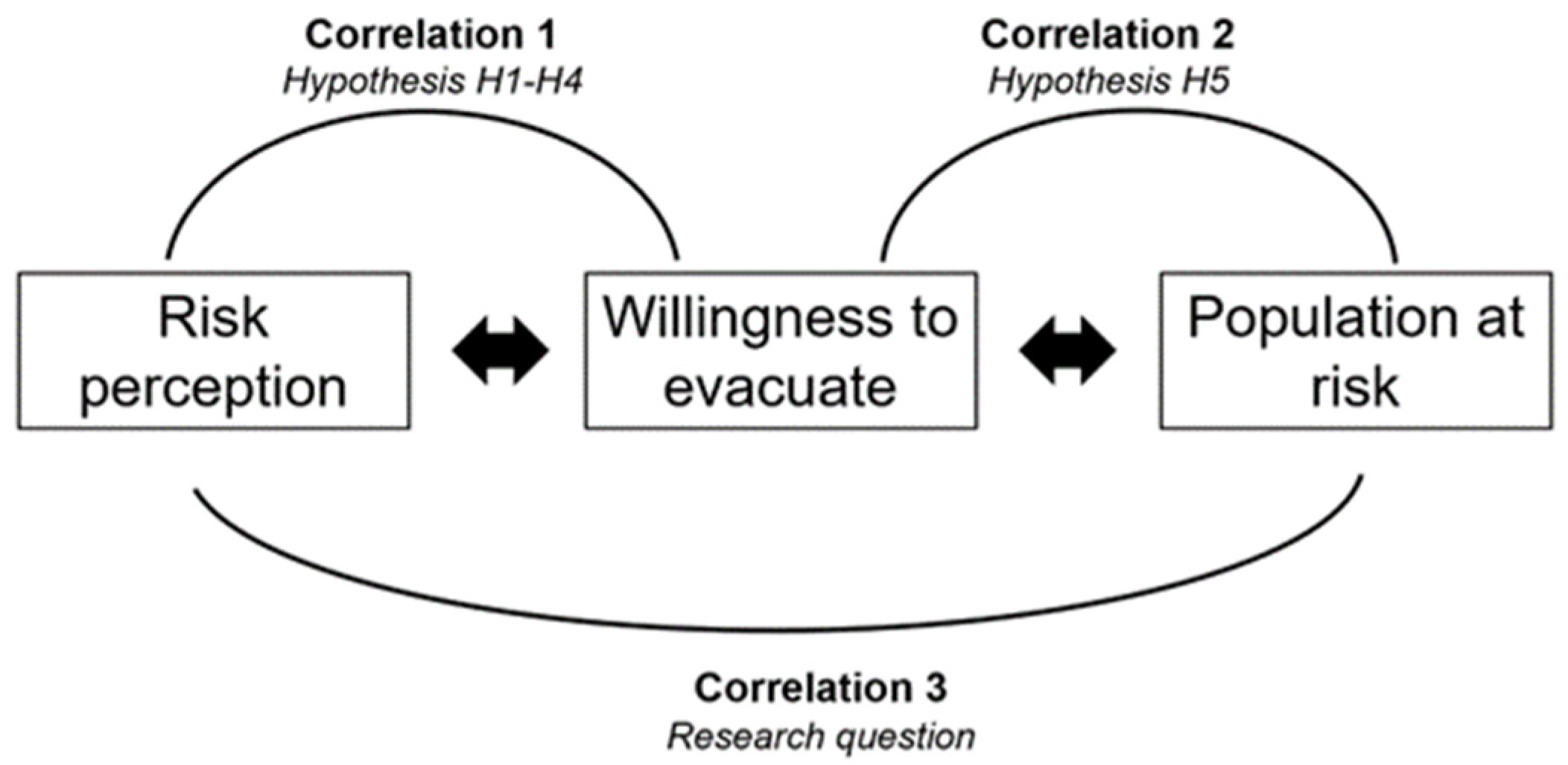
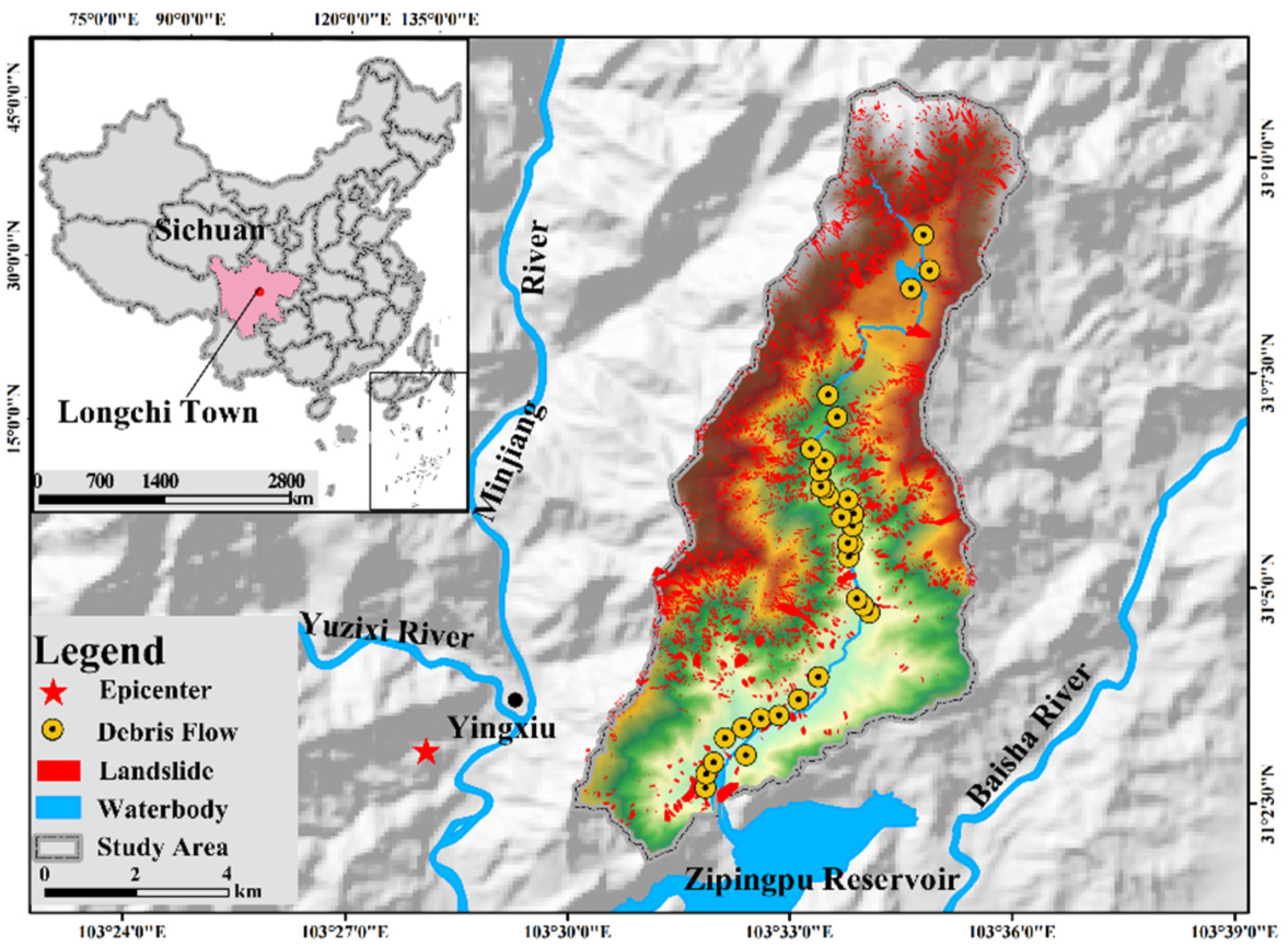
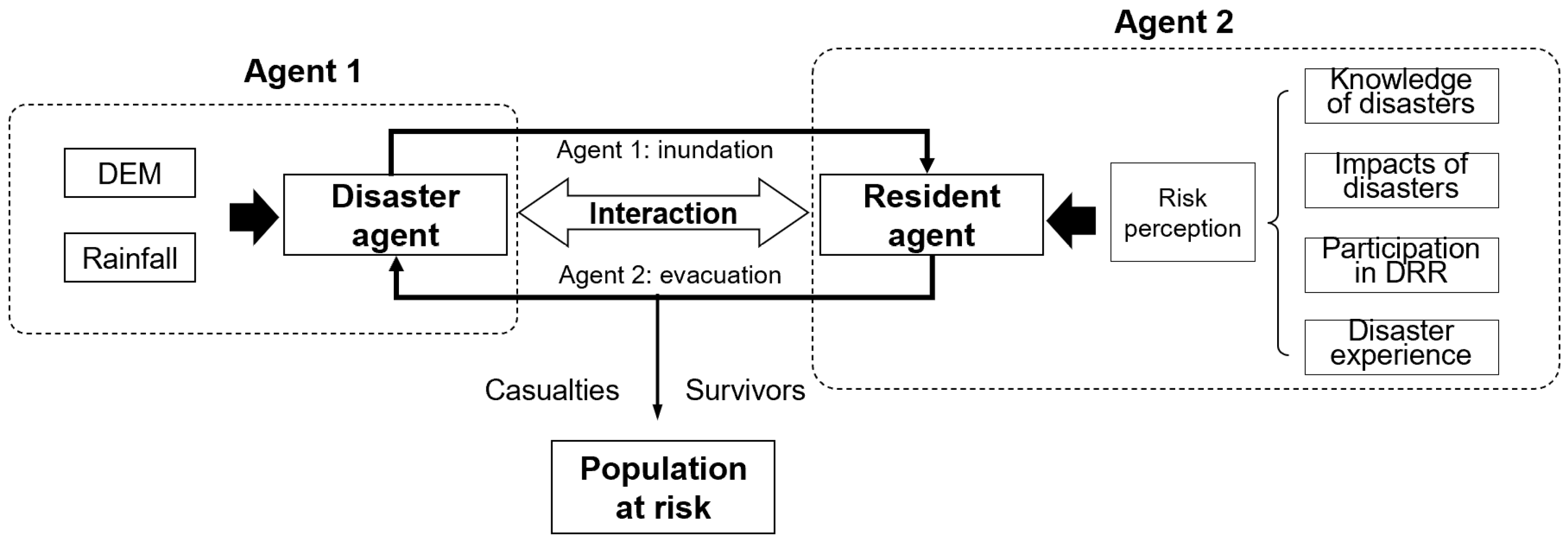

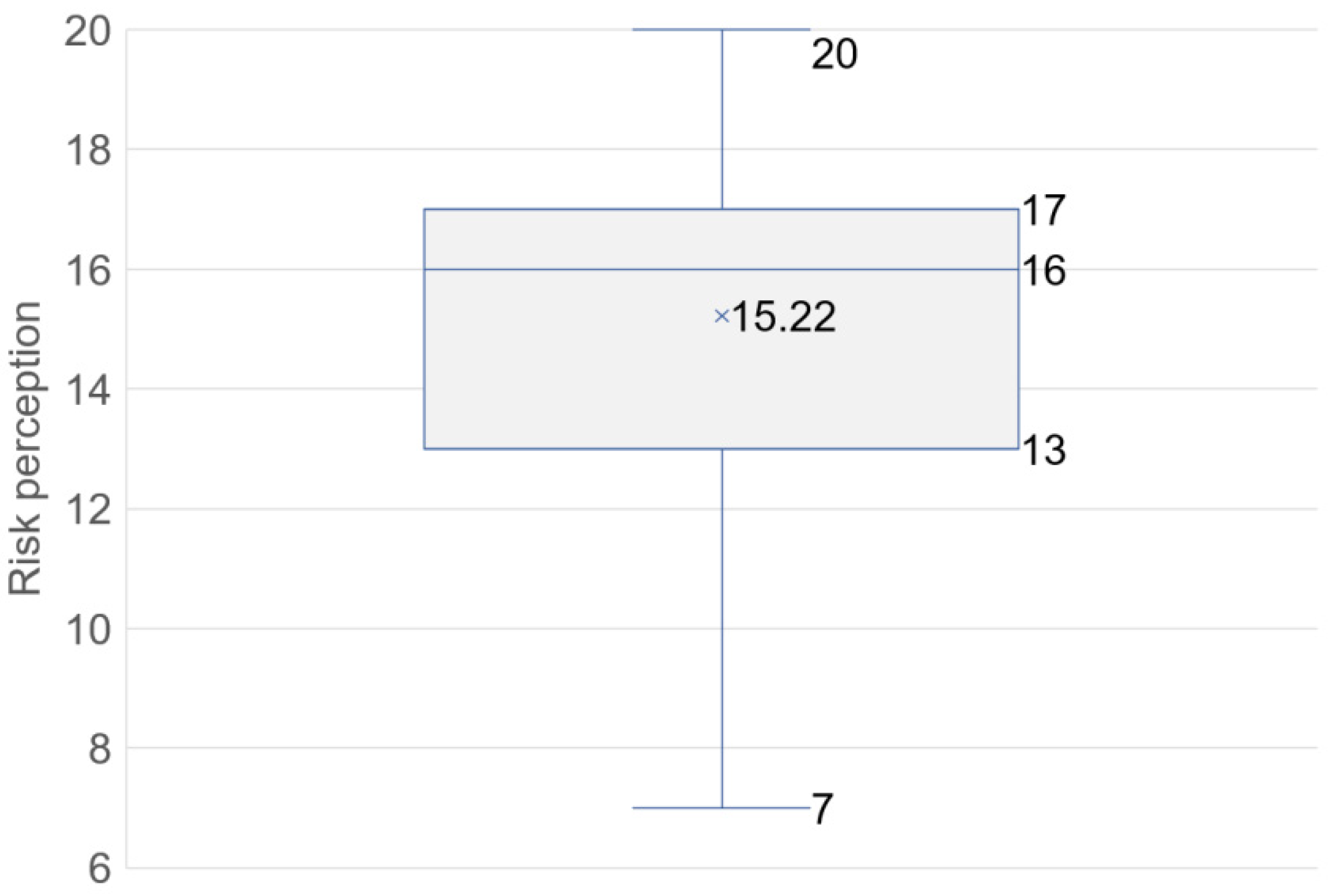
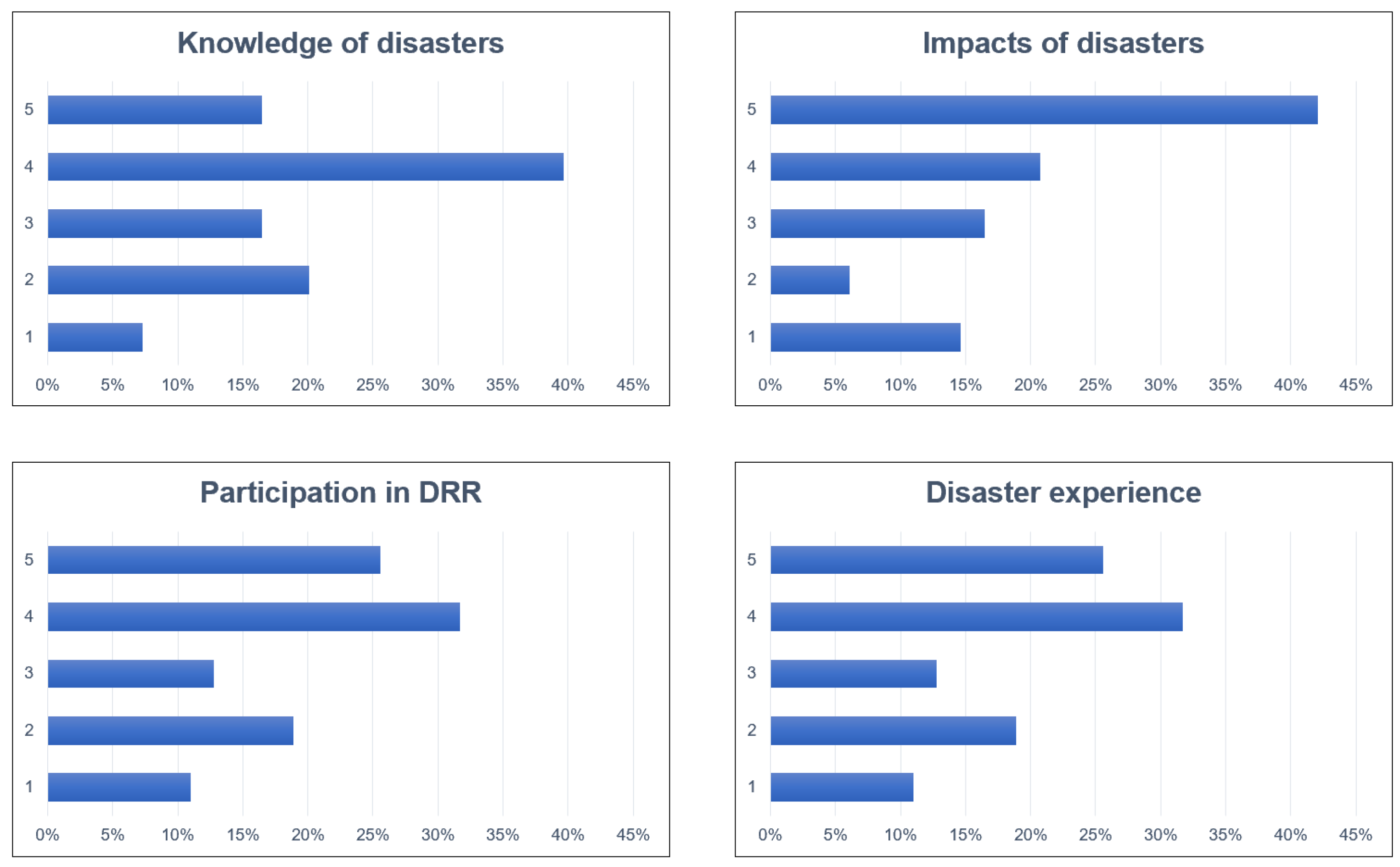


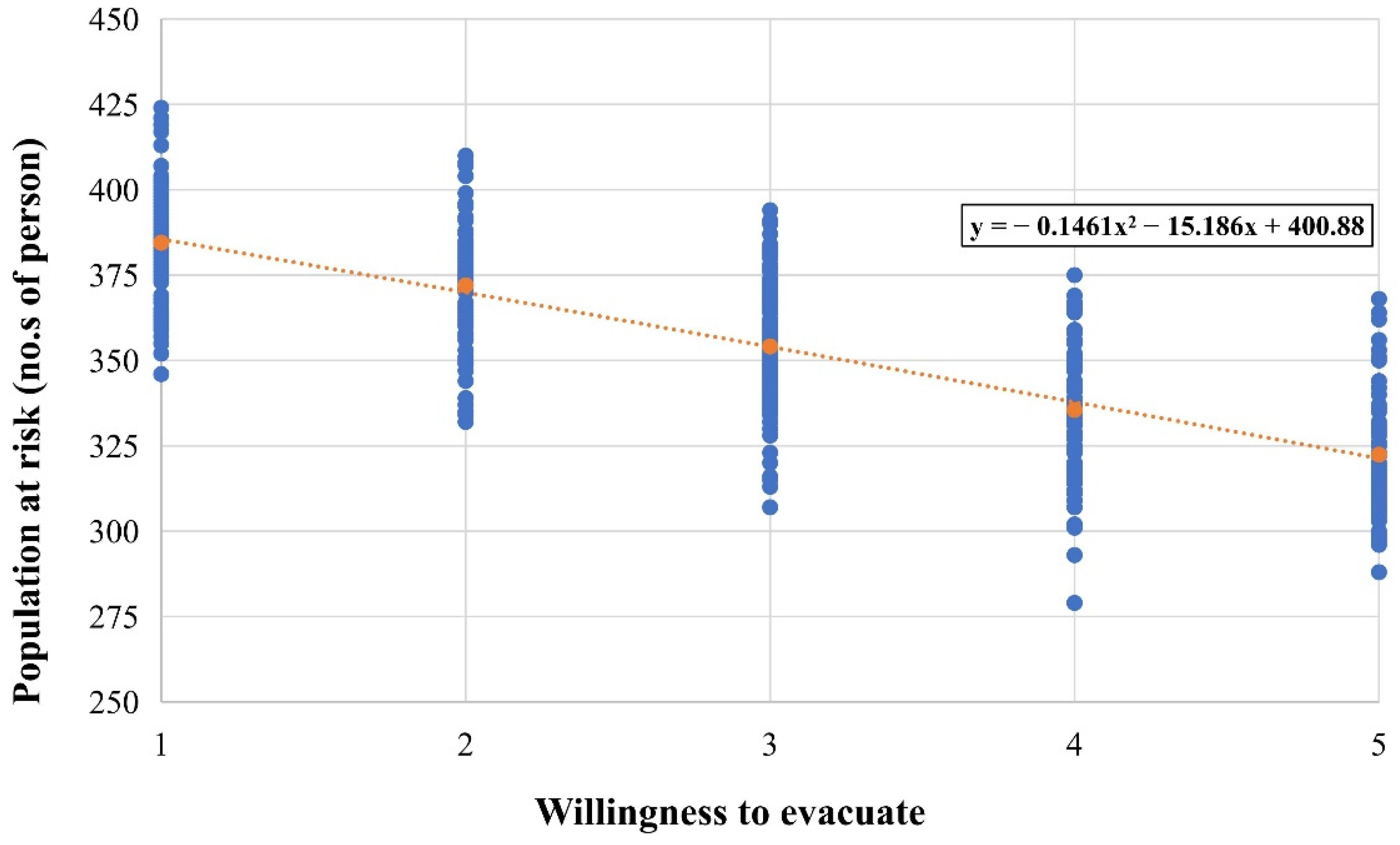
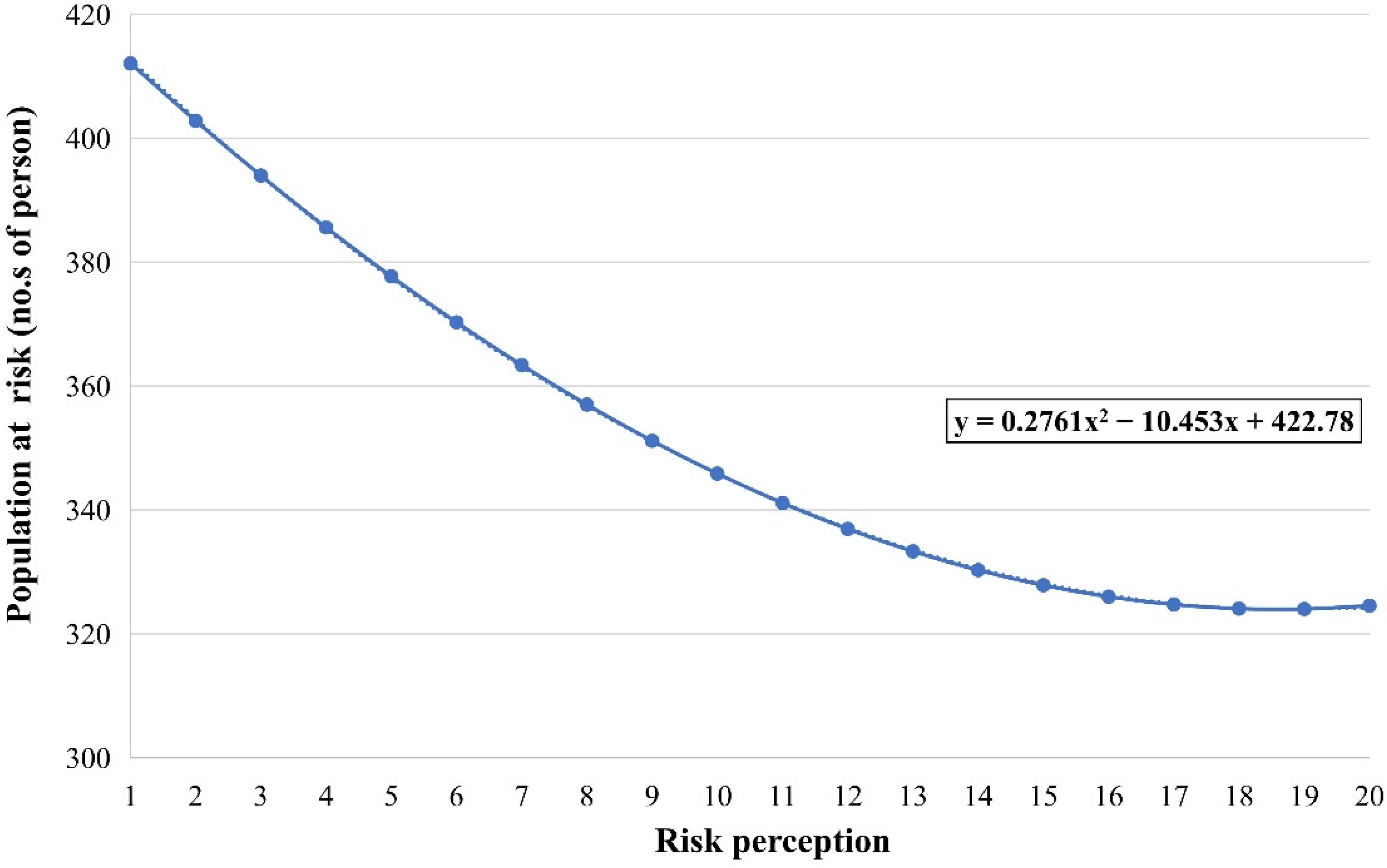
| Items | Categories | Proportion (%) |
|---|---|---|
| Gender | Male | 60 |
| Female | 41 | |
| Age | 18–25 | 2 |
| 26–30 | 7 | |
| 31–40 | 6 | |
| 41–50 | 26 | |
| 51–60 | 33 | |
| Over 60 | 26 | |
| Occupation | Business | 37 |
| Farming | 39 | |
| Others | 24 |
| Variables | No. | Variable Description and Definition | |
|---|---|---|---|
| a | knowledge to disasters | A1 | I know the main types of disasters in my community. |
| A2 | I know how to escape from these disasters. | ||
| A3 | I have access to disaster information, including early warnings, warning signs, evacuation routes. | ||
| b | Impacts of disasters | B1 | Disasters can harm me. |
| B2 | Disasters can have a serious impact on my properties. | ||
| B3 | Disasters can have a serious impact on Longchi town. | ||
| c | Participation in DRR | C1 | I would like to participate in local DRR activities. |
| C2 | I have participated in many DRR activities. | ||
| C3 | If I receive an early warning, I am willing to cooperate with the community for DRR. | ||
| d | Disaster experience | D1 | I have experienced disasters many times. |
| Variables | Willingness to Evacuation | ||||
|---|---|---|---|---|---|
| β | Standard Error | F | R² | Adjusted R² | |
| risk perception | 0.157 *** | 0.022 | 52.542 | 0.245 | 0.240 |
| knowledge to disasters | 0.193 *** | 0.051 | 22.478 | 0.361 | 0.345 |
| Impacts of disasters | 0.086 ** | 0.042 | |||
| Participation in DRR | 0.275 *** | 0.046 | |||
| Disaster experience | −0.142 | 0.080 | |||
Publisher’s Note: MDPI stays neutral with regard to jurisdictional claims in published maps and institutional affiliations. |
© 2022 by the authors. Licensee MDPI, Basel, Switzerland. This article is an open access article distributed under the terms and conditions of the Creative Commons Attribution (CC BY) license (https://creativecommons.org/licenses/by/4.0/).
Share and Cite
Wu, S.; Lei, Y.; Jin, W. An Interdisciplinary Approach to Quantify the Human Disaster Risk Perception and Its Influence on the Population at Risk: A Case Study of Longchi Town, China. Int. J. Environ. Res. Public Health 2022, 19, 16393. https://doi.org/10.3390/ijerph192416393
Wu S, Lei Y, Jin W. An Interdisciplinary Approach to Quantify the Human Disaster Risk Perception and Its Influence on the Population at Risk: A Case Study of Longchi Town, China. International Journal of Environmental Research and Public Health. 2022; 19(24):16393. https://doi.org/10.3390/ijerph192416393
Chicago/Turabian StyleWu, Shengnan, Yu Lei, and Wen Jin. 2022. "An Interdisciplinary Approach to Quantify the Human Disaster Risk Perception and Its Influence on the Population at Risk: A Case Study of Longchi Town, China" International Journal of Environmental Research and Public Health 19, no. 24: 16393. https://doi.org/10.3390/ijerph192416393
APA StyleWu, S., Lei, Y., & Jin, W. (2022). An Interdisciplinary Approach to Quantify the Human Disaster Risk Perception and Its Influence on the Population at Risk: A Case Study of Longchi Town, China. International Journal of Environmental Research and Public Health, 19(24), 16393. https://doi.org/10.3390/ijerph192416393






